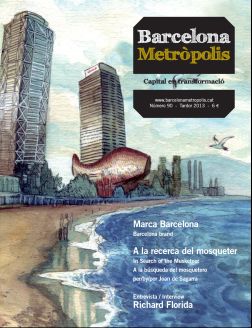 BarcelonABC. Alfabet d’una ciutat / A city alphabet
BarcelonABC. Alfabet d’una ciutat / A city alphabet- Jaume Subirana & Pepe Navarro
- Ajuntament de Barcelona
- Barcelona, 2013
- 272 pages
Never before have the inhabitants of Barcelona bestowed so much attention on their city. For several years now, the inhabitants of Barcelona have been rediscovering their city: history books fill the book shops, pictures by the old photographers (Ballell, Brangulí, Forcano, Pérez de Rozas, Colom, Català-Roca, Pomés, Miserachs, Maspons, Colita et al.) are reappearing, exhibitions at the City History Museum, the Contemporary Art Museum and the Contemporary Culture Centre are rescuing the past, there are historical routes, a literary Barcelona is unfolding, the blogosphere shows us the missing, hidden or picturesque Barcelona, which often goes unnoticed by passers-by. And nobody is more surprised than the inhabitants of Barcelona.
After the initial wounds of the Spanish Civil War had been covered up, the image of Barcelona was one of sad, blackened façades, as bleak as the long and seemingly interminable post-war period; the Barcelona of the housing estates, growing chaotically under the lights of the City of Fairs and Congresses, as we gradually forgot the luminous Barcelona of history under coats of plastic paint and unscrupulous property developers.
Barcelona is now a dynamic city, which has cleaned the scabs from its façades, has been opened up to the sea and has coaxed grass from concrete. But tourist interest has made it iconic, and, incapable of showcasing it in all its greatness and vitality –that which is usually termed the real city– monuments emerge as Sagrada Famílias transformed into landmarks on routes devised to prevent tourists from straying. And among the outsiders, the citizen of Barcelona is immersed in this maelstrom that feeds and stuffs the city, and turns its servile back on it.
However, the inhabitants of Barcelona are curious, and in recent years their need to explore and discover the hidden corners of history, their own and the city’s, has grown; this is of a city that is far removed from clichés and postcards, the city hidden amid the din. Yet dusting off the past is not enough. Someone had to recover the interest in stories; knowledge lacked a personal touch, through the eyes of someone with the sensitivity of knowing what they are talking about, capable of building a story and passing on this knowledge, gleaned from their own and others’ experience, conveying it as good storytellers do.
BarcelonABC. A city alphabet, with texts by Jaume Subirana and photographs by Pepe Navarro, is about all the above. A dictionary with entries that explain the city’s highlights with cross-references that allow us to leap, like chessboard knights, to information in other entries and at the same time construct a story around things that may or may not be so obvious but which are part of the author’s sensitivity, in the way that Jaume Subirana knows and understands the city he loves. The result is a walkabout with all the information that any decent guide should provide, as well as a literary immersion. As if in a novel, the voice of the author, who is also the main character, plunges us into fiction. Historical and well-documented, naturally, but seeking to create that context in which the reader makes their own story and recreates it.
It therefore goes without saying that BarcelonABC is both a guide and a dictionary for foreigners (the edition is bilingual, English–Catalan), but locals will find a different way of seeing the city in its pages and, in a certain way, of building it. Just like every game of chess, each reading is unique. After we have read the book, literature, as is its wont, transforms us, and we become a new citizen of Barcelona, and every reading yields a different Barcelona. And Barcelona does not exist until you have read it.
Note
Enric H. March, philologist and writer, is the author of the blog “Bereshit. The reconstruction of Barcelona and other worlds”.



